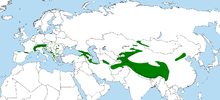Tichodroma
| Wallcreeper | |
|---|---|
 |
|
| Scientific classification | |
| Kingdom: | Animalia |
| Phylum: | Chordata |
| Class: | Aves |
| Order: | Passeriformes |
| Family: |
Tichodromidae Swainson, 1827 |
| Genus: |
Tichodroma Illiger, 1811 |
| Species: | T. muraria |
| Binomial name | |
|
Tichodroma muraria (Linnaeus, 1766) |
|
 |
|
| Synonyms | |
|
|
The wallcreeper (Tichodroma muraria) is a small passerine bird found throughout the high mountains of Eurasia from southern Europe to central China. It is the only extant member of both the genus Tichodroma and the family Tichodromidae.
There is some disagreement among ornithologists as to where the wallcreeper belongs in the taxonomic order. Initially, Linnaeus placed it in the family Certhiidae, along with the treecreepers. The wallcreeper is placed in a monotypic family Tichodromadidae by, amongst others, Clements 2007, while other authorities such as Dickinson 2003 put it in the monotypic Tichodromadinae, a subfamily of the nuthatch family Sittidae. In either case, it is very closely related to the nuthatches. At least one other species of wallcreeper is known from the fossil record, Tichodroma capeki (Late Miocene of Polgardi, Hungary)
The genus name Tichodroma comes from the Ancient Greek teikhos "wall", and dromos "runner". The specific muraria is Medieval Latin for "of walls", from Latin murus, "wall". Alternatively, the wallcreeper is named the red-winged wall creeper.
Two subspecies are recognized:
The wallcreeper is a 15.5–17-centimetre (6.1–6.7 in) long bird, with a mass of 17–19 grams (0.60–0.67 oz). Its plumage is primarily blue-grey, with darker flight and tail feathers. Its most striking plumage feature, though, are its extraordinary crimson wings. Largely hidden when the wings are folded, this bright colouring covers most of the covert feathers, and the basal half of the primaries and secondaries. The subspecies T. m. nepalensis is slightly darker than the nominate race.
Though largely silent, both male and female wallcreepers sing, the females generally only while defending feeding territories in the winter. The song is a high-pitched, drawn-out whistle, with notes that alternately rise and fall. During the breeding season, the male sings while perched or climbing.
...
Wikipedia

